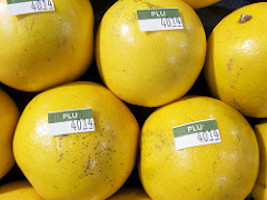
PLU codes are 4 or 5 digit numbers that appear on a small sticker applied to an individual piece of fresh produce. The PLU number identifies produce items based upon various attributes which can include the commodity, variety, growing methodology (e.g. organic), and the size. The PLU coding system is voluntary, and not mandated by any governing body. There are currently over 1400 PLU codes issued for fresh produce and produce related items such as nuts and herbs.
These numbers are assigned by an association called the International Federation of Produce Standards. These PLU or Price Look Up codes have been used by supermarkets since 1990 to make check-out and inventory control easier, faster and more accurate. PLU codes are used to identify bulk produce (and related items such as nuts and herbs). They tell the supermarket cashier whether an apple is say, a conventionally grown Fuji apple which may sell for $1.29 per pound versus an organically grown Fuji apple which may sell for $2.29 per pound.
PLU codes ensure that the accurate price is paid by consumers by removing the need for cashiers to identify the product and whether or not it is conventionally or organically grown. The 4-digit PLU codes are randomly assigned within a series of numbers within the 3000 and 4000 series.
A 9 in front of the 4-digit number means it’s organically grown. Moves to add an 8 for genetically modified produce have been widely ignored.